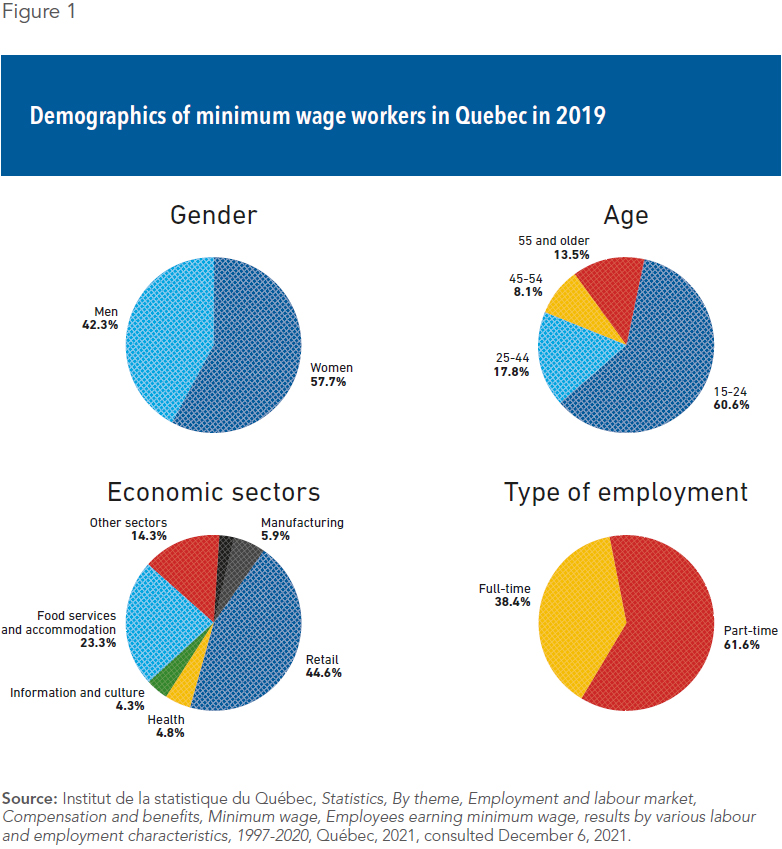The Unintended Negative Consequences of Significantly Raising the Minimum Wage

Viewpoint setting the record straight regarding minimum wage earners and the businesses that employ them
Following Minister Jean Boulet’s announcement that the minimum wage in Quebec will go from $13.50 to $14.25 an hour, certain community groups and unions suggested that this was a missed opportunity to raise it to $18 an hour. The authors of this publication conclude that even though a hike to $18 an hour may seem beneficial for low-income workers, this steep 33% increase would have negative consequences on the financial health of a range of companies in the retail, food services, and accommodation sectors. They even maintain that many workers in these sectors could lose their jobs.
 Related Content
Related Content
 |
 |
 |
| Hausse du salaire minimum: une politique efficace? (Le Soleil, January 18, 2022)
Salaire minimum: l’IEDM avertit contre les effets pervers d’une hausse excessive (Le Journal de Montréal, January 18, 2022) Hausse excessive du salaire minimum: « Prioriser l’éducation et la formation au lieu de la facilité », selon l’IEDM (Vingt55, January 18, 2022) Groups call for higher increase to Quebec’s minimum wage (HR Reporter, January 19, 2022) Minimum wage hike: An effective measure? (IEDM.ORG, January 20, 2022) Quebec right to avoid significant minimum wage hike: MEI (The Suburban, January 26, 2022) |
This Viewpoint was prepared by Maria Lily Shaw, Economist at the MEI, and Gabriel Giguère, Public Policy Analyst at the MEI. The MEI’s Taxation Series aims to shine a light on the fiscal policies of governments and to study their effect on economic growth and the standard of living of citizens.
The minimum wage has once again entered the spotlight, the most recent announcement being that it will increase from $13.50 to $14.25 an hour on May 1st, 2022. This 5.6% hike is seen as a disappointment by unions and activist groups(1) that are demanding an immediate increase to $18/hour, a 33% jump. While such an increase might seem very generous to low income workers at first glance, it should not be implemented without evaluating its costs, both for workers and the businesses that employ them.
Vulnerable Companies
No fewer than nine out of ten small and medium-sized enterprises would be directly affected by such a minimum wage hike.(2) Retail employs 45% of all minimum wage workers, the largest percentage of any sector, followed by the accommodation and food services sector with 23%. Together, these two sectors thus account for 68% of minimum wage earners, a total of over 182,000 employees.(3)
These sectors also have very low profit margins.4 Businesses in these sectors don’t have much left over once they have paid their taxes and subtracted their administrative and operating expenses such as material, labour, and manufacturing costs.(5) The profit margins for gas stations and restaurants, for example, are less than 3%,(6) meaning that for every $100 they make in sales, they take home a net surplus of only $3 once they have paid their employees and covered their other expenses.
There is no doubt that a sudden and drastic hike in the minimum wage would jeopardize the financial health of many businesses in the retail, food services, and accommodation sectors. To reduce expenses, these businesses would be forced to resort to laying off employees, cutting hours, or passing the bill on to consumers. As a result, some of the 182,000 minimum wage workers in these sectors would be at risk of losing their jobs.
The Typical Minimum Wage Worker in Quebec
According to a widespread belief, the typical minimum wage worker in Quebec is a single mother. This stereotype, however, is far from reflecting the reality of the matter.
Although women did make up a higher percentage of minimum wage workers (58%)(7) in 2019, that doesn’t mean that these workers were mostly single mothers. In fact, no less than 60.6% of minimum wage workers are between the ages of 15 and 24.(8) They are therefore mostly young people, who are statistically less likely to have a child in their care(9) compared to workers aged 25 to 44, who make up only 17.8% of minimum wage workers, or one quarter as many.(10) Furthermore, 74% of people aged 15 to 24 still live with at least one of their parents,(11) a situation typical of students. Also, 61.6% of minimum wage workers have a part‑time job,(12) which is the case for most students with employment.(13) (See Figure 1.)

The typical minimum wage worker in Quebec is therefore between 15 and 24 years of age and has a part-time job in retail, food services, or accommodation. This is a far cry from the scenario frequently painted by political parties of the precarious single mother, who makes up only a small fraction of such workers.(14) Still, it is worth taking a closer look at the after-tax income of single‑parent families, which is also not what you would expect.
A Much Higher Net Income
Working for minimum wage as a single parent does not have the same consequences as for part‑time students. Indeed, the tax system factors in the needs and responsibilities of a person with dependent children, a fact that is too often ignored in conversations on hiking the minimum wage.
Picture a single parent working 35 hours a week for 52 weeks a year. In 2021, their hourly wage of $13.50 works out to an annual gross income of $24,570.(15) Those seeking to justify major increases in the minimum wage often stop here, which does not provide us with an accurate picture of the situation of these workers. Single parent workers actually receive an additional $12,615 in various benefits. After subtracting taxes and contributions, their annual net income amounts to $34,672 (see Table 1), which effectively takes them from $13.50 to $19.05 an hour. This net wage is higher than the increase being demanded by unions.

Conclusion
A dramatic hike in the minimum wage, were it to be adopted, would have a negative impact on the very workers it seeks to assist and on Quebec’s economy in general. It would jeopardize the jobs of typical minimum wage workers, namely students with part‑time positions in sectors that might not be able to absorb such an increase, given their very thin profit margins. As for single mothers, often used to illustrate the plight of minimum wage workers, their situation is not at all representative of the category. Furthermore, there exist other, more effective and less economically harmful methods to directly assist single mothers, such as education and training, as well as more targeted measures.
References
- Jean-Francois Desbiens, ”Salaire minimum : ’une autre occasion ratée’, estime la Coalition Minimum 18 $,” néomédia, January 15, 2022.
- Canadian Federation of Independent Business, “Les PME québécoises et le salaire minimum,” November 2021, p. 3.
- Authors’ calculations. Institut de la statistique du Québec, Statistics, By theme, Employment and labour market, Compensation and benefits, Minimum wage, Employees earning minimum wage, results by various labour and employment characteristics, 1997-2020, Québec, May 12, 2021.
- Statistics Canada, Table 33-10-0006-01: Financial and taxation statistics for enterprises, by industry type, 2021.
- For more detail: Business Development Bank of Canada (BDC), Articles and tools, Entrepreneur’s toolkit, Financial tools, Net profit margin.
- Statistics Canada, op. cit., endnote 4.
- Institut de la statistique du Québec, op. cit., endnote 3.
- Idem.
- Institut de la statistique du Québec (ISQ), Births and fertility rate by age of mother, Québec, 2013-2020, March 18, 2021.
- Institut de la statistique du Québec, op. cit., endnote 3.
- Authors’ calculations. This is a weighted average for data from 2016. Institut de la statistique du Québec, Regard statistique sur la jeunesse, État et évolution de la situation des Québécois âgés de 15 à 29 ans, 1996 à 2018, February 2020, p. 22; Institut de la statistique du Québec, Population of Québec by age and sex, July 1st, 1971-2021, September 29, 2021.
- Institut de la statistique du Québec, op. cit., endnote 3.
- Pierre-Paul Biron and Magalie Lapointe, “Nos jeunes commencent à travailler de plus en plus tôt,” Le Journal de Québec, January 3, 2020.
- Marie-Ève Dumont, “Elle a élevé trois enfants alors qu’elle gagnait 9$ de l’heure,” Le Journal de Montréal, March 12, 2018; Government of Quebec, News, “Mise à jour économique : Québec solidaire demande des mesures phares pour lutter contre la pauvreté,” Québec Solidaire’s parliamentary wing, November 21, 2017.
- Suzie St-Cerny, Luc Godbout, and Matis Allali, Ménage québécois travaillant au salaire minimum : des comparaisons, Chaire de recherche en fiscalité et finances publiques, April 2021, p. 19.

